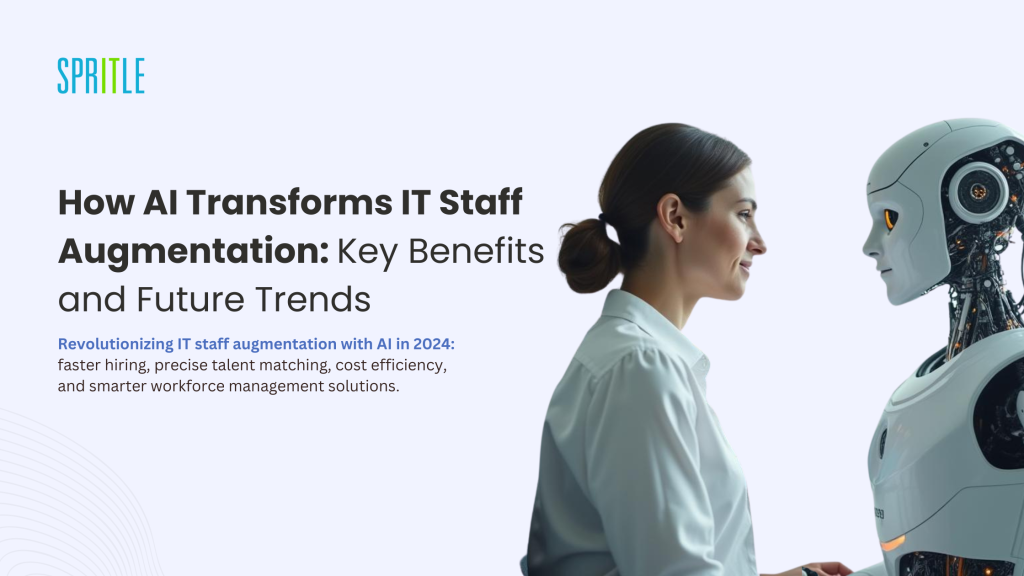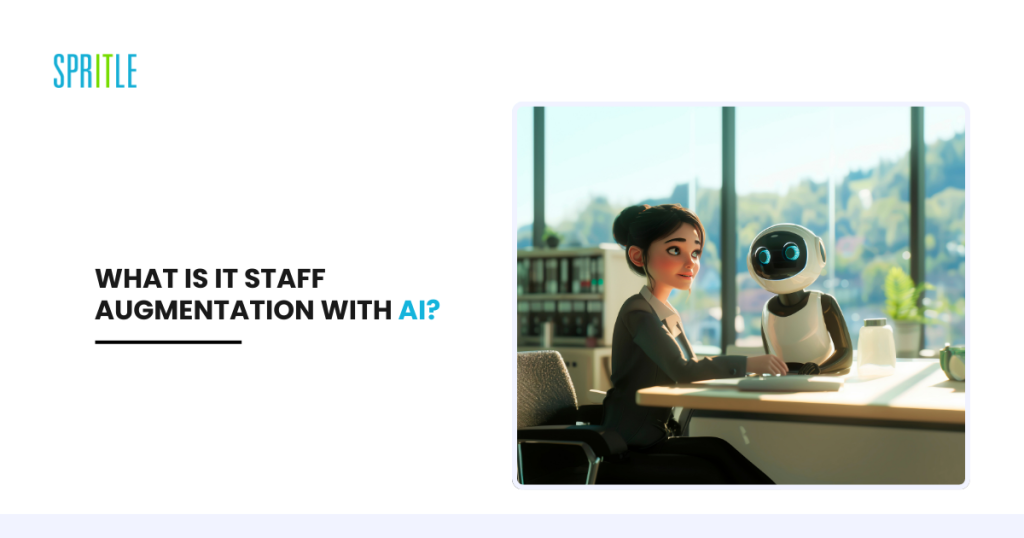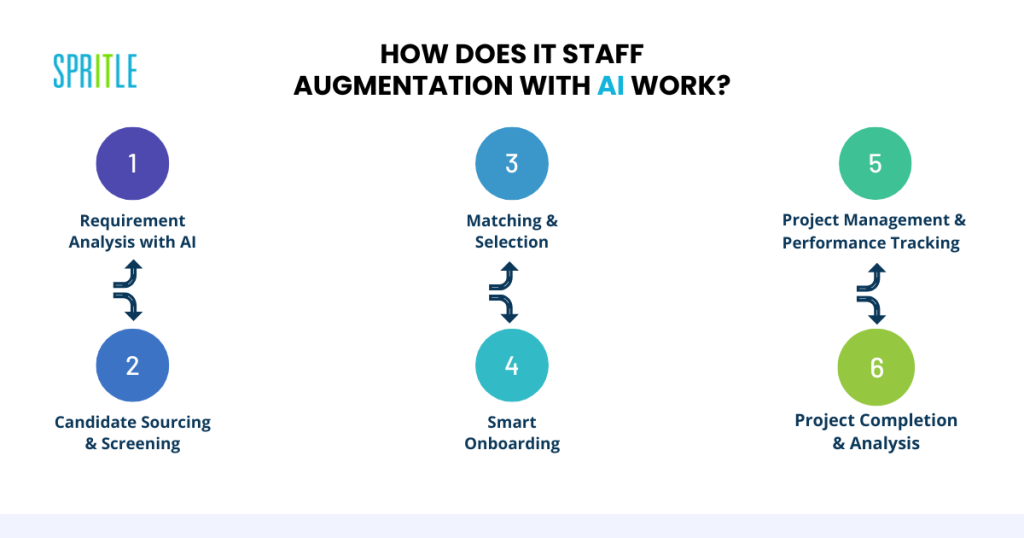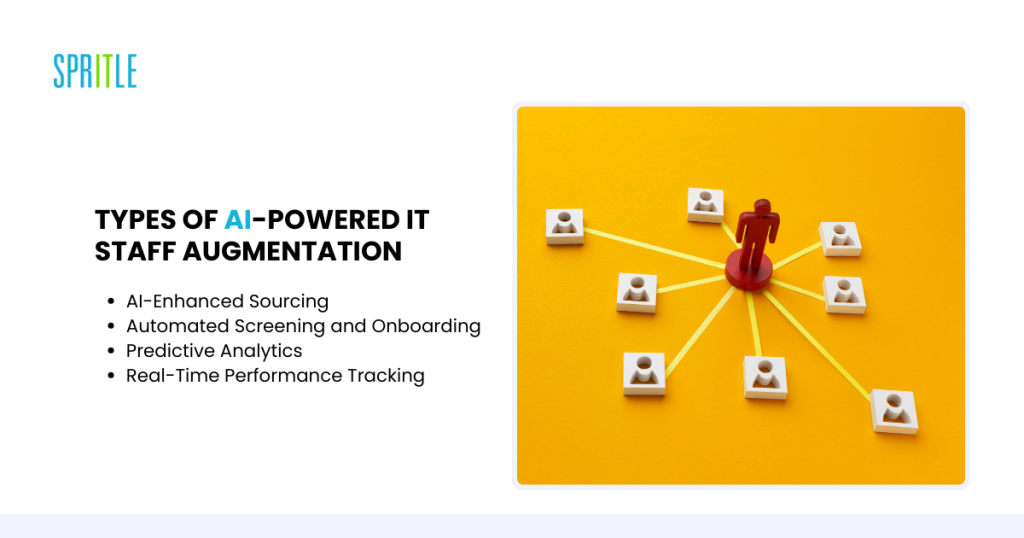
Introduction
In 2024, the integration of artificial intelligence (AI) into IT staff augmentation is revolutionizing the way companies approach flexible staffing. By combining AI with staff augmentation, businesses gain access to enhanced decision-making tools, more efficient processes, and data-driven strategies that can meet their evolving demands. This guide delves into how AI is transforming IT staff augmentation, its benefits, challenges, types, applications, and a look into future possibilities.
What is IT Staff Augmentation with AI?

IT staff augmentation with AI refers to the use of AI-driven tools and processes to streamline and enhance the hiring, management, and integration of augmented IT staff. AI technology assists in identifying talent, predicting project needs, optimizing onboarding, and even managing workflows, making the process faster, smarter, and more efficient.
Why Use AI in IT Staff Augmentation in 2024?
The combination of AI with IT staff augmentation is gaining traction due to several compelling reasons:
- Enhanced Talent Matching: AI algorithms analyze resumes, skill sets, and project requirements to find the best match, reducing hiring time and increasing fit quality.
- Improved Decision-Making: AI-driven insights help in forecasting demand, assessing budget impacts, and planning workforce needs.
- Streamlined Processes: AI automates repetitive tasks like resume screening, candidate outreach, and onboarding documentation, saving time and effort.
Reduced Costs: AI-powered automation and analytics help optimize staffing costs by predicting project needs and managing resources effectively.
How Does IT Staff Augmentation with AI Work?
The process of integrating AI into IT staff augmentation typically involves the following steps:
- Requirement Analysis with AI: AI algorithms analyze job descriptions and project needs to determine the specific skills and qualifications required.
- Candidate Sourcing & Screening: AI-powered platforms search through vast talent pools, assessing candidates based on skills, experience, and compatibility, while filtering out unqualified profiles.
- Matching & Selection: AI tools evaluate candidate compatibility with the existing team and project needs, ensuring a high-quality match.
- Smart Onboarding: AI-based tools assist in onboarding, helping new team members adapt quickly through automated introductions, training schedules, and documentation.
- Project Management & Performance Tracking: AI tools monitor performance metrics, provide insights into productivity, and help predict future staffing needs for ongoing projects.
- Project Completion & Analysis: AI tools track project outcomes and assess resource effectiveness, offering data to refine future staff augmentation strategies.

Types of AI-Powered IT Staff Augmentation
- AI-Enhanced Sourcing: Uses machine learning to find and rank candidates based on skill match, experience, and cultural fit.
- Automated Screening and Onboarding: AI tools pre-screen candidates and manage onboarding steps to ensure smooth integration.
- Predictive Analytics: Helps in forecasting staffing needs by analyzing historical data, project scopes, and timelines.
- Real-Time Performance Tracking: AI-based tools track productivity and project milestones, providing actionable insights to manage augmented staff effectively.

Advantages of AI-Driven IT Staff Augmentation
- Faster Talent Acquisition: AI speeds up the sourcing and screening process, reducing time-to-hire and project delays.
- Better Skill Matching: AI-driven analytics match candidates based on exact skill sets and project needs, leading to better team alignment.
- Reduced Administrative Burden: AI automates repetitive tasks, freeing up HR and project managers to focus on strategic decision-making.
- Cost Optimization: AI tools provide insights on budget management, resource allocation, and cost-effectiveness.
- Scalability: AI enables businesses to quickly scale teams up or down based on predictive analytics and demand forecasting.
Challenges of AI in IT Staff Augmentation
- Data Privacy Concerns: Managing sensitive data about candidates and employees requires strict adherence to privacy regulations.
- Dependence on Data Quality: AI performance relies on high-quality data; inaccurate data can lead to poor hiring decisions.
- Integration with Existing Systems: Adopting AI-based systems can be challenging if they don’t integrate seamlessly with current tools and workflows.
- Bias in AI Algorithms: AI tools may unintentionally favor certain candidate profiles based on biased data, which can affect diversity and inclusion.
Applications of AI in IT Staff Augmentation
AI-powered IT staff augmentation is highly versatile and can be used in multiple scenarios:
- Project-Specific Staffing: AI identifies candidates with niche skills for specific projects, such as AI, data science, or cybersecurity.
- Seasonal Hiring: Companies facing seasonal demand spikes can use AI to forecast hiring needs and match candidates efficiently.
- Skill Gap Analysis: AI assesses skill gaps in existing teams and suggests the type of talent needed to fill those gaps.
- Remote Workforce Management: AI tracks productivity and performance, making it easier to manage remote or hybrid augmented teams.
Conclusion
As we move further into 2024, AI is proving to be a game-changer in IT staff augmentation. By automating and enhancing every step of the process, AI-powered tools make it easier for businesses to find, manage, and retain top talent. However, companies should also be mindful of the challenges, such as data privacy, integration issues, and potential biases in algorithms. With a clear understanding of AI’s role and benefits, businesses can leverage this powerful combination to stay agile, competitive, and cost-effective.
5 FAQs
- How does AI improve IT staff augmentation?
AI speeds up recruitment, improves candidate matching, and enhances workforce management, making the process faster and more efficient. - What are the benefits of using AI for candidate screening?
AI-driven screening reduces time spent on resume reviews, identifies the best fit based on skills, and improves overall hire quality. - Is AI-driven staff augmentation cost-effective?
Yes, by streamlining processes and optimizing resource allocation, AI helps reduce overall staffing costs. - How can AI predict staffing needs?
AI tools analyze past projects, current workloads, and future requirements, enabling companies to forecast staffing demands accurately - Are there any risks of bias in AI-powered staffing?
Yes, biases can arise from historical data; companies should regularly review and fine-tune algorithms to ensure fairness in candidate selection.
